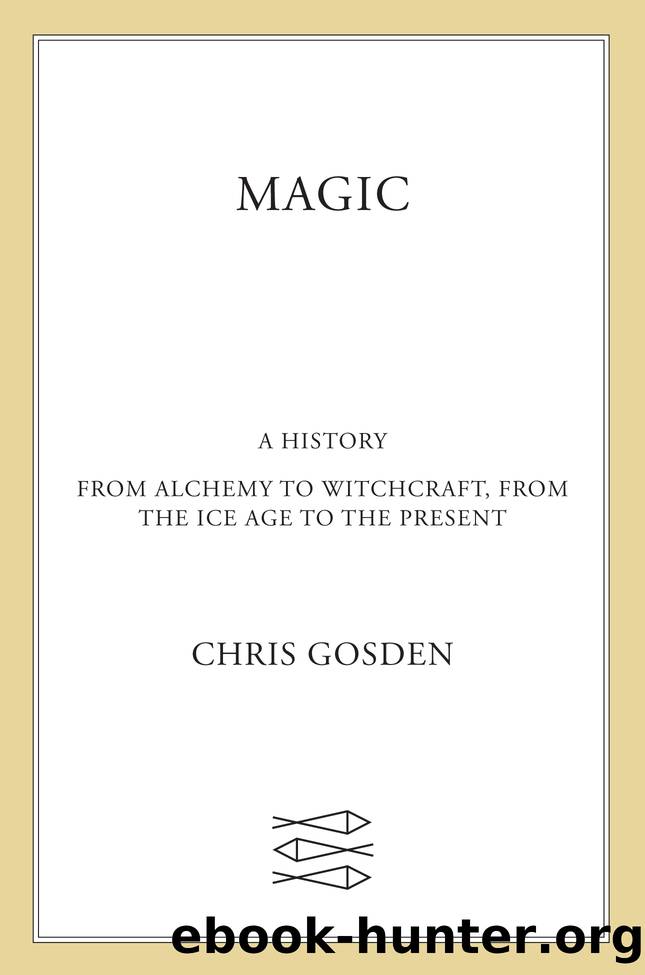Magic: A History by Chris Gosden

Author:Chris Gosden
Language: eng
Format: epub
Publisher: Farrar, Straus and Giroux
Hybrid cultures in the northern Roman provinces
In north-west Europe formalized religion and religious structures, such as temples and shrines, appeared in the Roman Period for the first time (or some at the very end of the Iron Age, probably due to impulses coming from the Roman world). New temples and shrines employed priests who led more formalized modes of worship. However, careful and deliberate deposition of coins, other forms of metalwork and probably organic substances regularly occurred on temple sites.16 Powerful objects were still thrown into rivers, bogs and deposited on settlement sites following rules of care established in the Iron Age and earlier. Under Roman influence much changed: populations grew, levels of material use exploded (it is possible that the level of population and of material things only reached Roman levels again in the Tudor Period), but also towns were formed, military camps and forts were built to be connected by new roads, and villas were constructed. Much in the basic fabric of peopleâs lives changed. Surprisingly there were also elements of life that stayed much the same, as people across the empire made a choice to adopt new Roman ways, to resist them through maintaining old lifestyles, or to attempt to blend the old and the incoming culture into something quite new. Increasingly a blended culture emerged in places like Roman Britain, with the Roman element evident, for example, in straight roads, a more rational calculation encouraged by taxation and the imposition of bureaucracy. But older British ways persisted, not just through a reciprocal relationship with the landscape and deposition, or the continuance of Iron Age art styles to the end of the Roman Period and beyond, but also in peopleâs refusal to adopt the new rectangular architecture, sticking instead to their tradition of round houses.
At an even more basic level, considerable elements of the Roman landscape were laid out following Iron Age alignments. We saw that important elements of the Stonehenge landscape and of earlier Neolithic monuments were aligned on the midwinter and midsummer solstices. When Stonehenge went out of use around 1500 BCE, field systems were laid out for the first time, with the central axes of these fields often aligned with the solstices. Fields are laid out and relaid down to the end of the Roman Period in places like Britain. Although the detailed structure of the fields changed, the overall alignment did not. The agricultural landscape was a spatial arrangement, but it also had time encoded into it, possibly with important ceremonies at midwinter and midsummer. Fields were not just practical but cosmological, and this cosmology had such power it lasted for almost 2,000 years, by which time Britain had become Christian. It was not just the objects placed into the landscape that indicate magic but the very layout of the landscape itself.
Download
This site does not store any files on its server. We only index and link to content provided by other sites. Please contact the content providers to delete copyright contents if any and email us, we'll remove relevant links or contents immediately.
| Africa | Americas |
| Arctic & Antarctica | Asia |
| Australia & Oceania | Europe |
| Middle East | Russia |
| United States | World |
| Ancient Civilizations | Military |
| Historical Study & Educational Resources |
Magic and Divination in Early Islam by Emilie Savage-Smith;(1500)
Ambition and Desire: The Dangerous Life of Josephine Bonaparte by Kate Williams(1344)
Bohemians, Bootleggers, Flappers, and Swells: The Best of Early Vanity Fair by Bohemians Bootleggers Flappers & Swells- The Best of Early Vanity Fair (epub)(1343)
Papillon by Henry Charrière(1310)
Twelve Caesars by Mary Beard(1256)
Operation Vengeance: The Astonishing Aerial Ambush That Changed World War II by Dan Hampton(1135)
What Really Happened: The Death of Hitler by Robert J. Hutchinson(1128)
London in the Twentieth Century by Jerry White(1112)
Time of the Magicians by Wolfram Eilenberger(1089)
The Japanese by Christopher Harding(1086)
Twilight of the Gods by Ian W. Toll(1084)
Lenin: A Biography by Robert Service(1045)
The Devil You Know by Charles M. Blow(985)
A Social History of the Media by Peter Burke & Peter Burke(936)
Freemasons for Dummies by Hodapp Christopher;(922)
Napolean Hill Collection by Napoleon Hill(902)
Henry III by David Carpenter;(891)
The Churchill Complex by Ian Buruma(881)
The Rise and Triumph of the Modern Self by Unknown(879)
